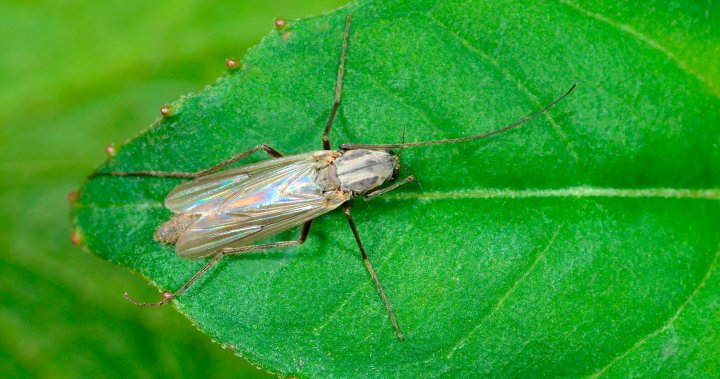As spring is in full force and the warmer days are ahead, those by Toronto’s lakeside particularly know all too well the season comes with swarms of midges.
Many who live by the lake or frequent the boardwalk will start to see hundreds of the tiny little insects flying around in swarms this time of year.
But what purpose do they serve, and how long are they around for?
Here is what we know.
Antonia Guidotti, an entomologist with the Royal Ontario Museum, says the flies start off as larvae and live in the water at Lake Ontario.
They are aquatic and feed on sediments, such as organic and decaying material, at the bottom of the lake.
“When they emerge out of water as adults, they fly,” Guidotti said.
“They have one pair of wings. They’re flies.”
She said they all tend to emerge all at the same time, leading to the huge swarms people see.
And they are mostly males in the swarms, until a female arrives and they mate. It also increases their chance of being able to reproduce because of the sheer number of them.
Guidotti said the ones we see in Toronto do not bite.
Although there are hundreds of different species, she said what we see in Toronto are specifically called Chironomidae — a family a flies that are non-biting.
“They don’t live very long,” Guidotti said.
Breaking news from Canada and around the world
sent to your email, as it happens.
Midges have a short life span, from just a few days to a couple of weeks at most, and then they are gone.
However, Guidotti said they will be seen a few times over the summer because there are so many different species that emerge at different times.
Guidotti said it could be one type, and then in another week or two, another emerges. There can also be more than one generation.
Some people may start to see them now in April until the end of August, and maybe another swarm of them in September, she said.
The beginning of May is when people can expect to see one of the bigger emergences because everything this year is coming out a couple weeks sooner, she said. It could even be sooner when compared to other years, Guidotti added.
However, she notes midges need to stay by the water, so those who live even just a little more north than the lakeside won’t see them.
The flies are attracted to light, so turning off the lights is a good way to keep them out, Guidotti said.
She also suggests keeping screens on doors and windows if you have them open, though it’s best to keep the doors and windows closed.
She does not suggest using zappers, as they will kill a lot of the beneficial insects feeding on the midges.
Ultimately, she suggests to “just wait them out.”
“It’s going to pass,” Guidotti said.
“They’ll go back to the females and will lay the eggs, and they’ll die off.”
Chironomidae flies are a very important part of the ecosystem, Guidotti said.
They are important food for fish and other aquatic animals when they are living in the water, and when they emerge as flies, they are important bird food as well.
“With a lot of insects declining in numbers, they are an even more important part of the food chain,” Guidotti said.
In Ontario alone, there are more than 800 species recorded, Guidotti said.
A very small number of them are in the Toronto area, with the rest across the province.
However, they all emerge at different times depending on the temperature and other variables, she said.
© 2024 Global News, a division of Corus Entertainment Inc.




